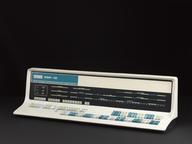









Computer and coding kit prototype, Kano, 2012-2014. Consists of Raspberry Pi ©2011.12, keyboard, USB stick, KANO software, case in three pieces, two KANO cards, plug adapter (UK) and power (2 parts), two cables (USB flat cable and HDMI cable) and one instruction manual (Book 1: make a computer). This was the prototype which was developed for the Kickstarter campaign in 2013. The company successfully raised $1,522,160.
Made of plastic: alloying polymers including ABS, PP, PE; Acrylics Copper encapsulated wires with gold and nickel coated connectors; PCB is glass reinforced with components held with lead free solder; The ICs utilise a silicone wafer thickness of as little as 120 nano meters; recycled paper.
This Kano kit was a prototype developed by London-based company, Kano, in 2012. Powered by a Raspberry Pi, the kit is designed to de-mystify the inner workings of a computer by revealing the hardware within. The kit instructs users on how to build it and then how to code through fun games and unlocking levels. This kit represents an effort to make computing open and inclusive and creates room for innovation and creativity.
The company was funded through crowdfunding, raising in total over $40 million between 2013 and 2017, making it one of the most successful UK crowdfunding campaigns. The original crowdfunding campaign used this prototype to generate funding. One of the backers of the original Kano campaign was Apple Co-Founder, Steve Wozniak. This kind of community funding has recently exploded, and Kano has harnessed the benefits of it claiming to have generated innovative ideas around case design, business models and education packages. Kano has also created ‘Kano World’ which is an online repository for projects that users have created using their Kano computers. This is a place where users can share their work and learn from others.
Details
- Category:
- Computing & Data Processing
- Object Number:
- 2018-220
- Materials:
- plastic (unidentified), copper (metal), gold (metal), nickel plated, glass and paper (fibre product)
- type:
- computer kit




